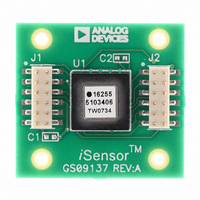ADIS16255/PCBZ Analog Devices Inc, ADIS16255/PCBZ Datasheet - Page 10

ADIS16255/PCBZ
Manufacturer Part Number
ADIS16255/PCBZ
Description
BOARD EVAL FOR ADIS16255
Manufacturer
Analog Devices Inc
Series
iMEMS®, iSensor™r
Specifications of ADIS16255/PCBZ
Sensor Type
Gyroscope, 1 Axis (Yaw Rate)
Sensing Range
±80°/sec, ±160°/sec, ±320°/sec
Interface
SPI Serial
Sensitivity
0.018°/sec/LSB
Voltage - Supply
4.75 V ~ 5.25 V
Embedded
No
Utilized Ic / Part
ADIS16255
For Use With
ADISUSBZ - KIT EVAL ADIS W/SOFTWARE USBADISEVALZ - KIT PC EVALUATION W/SOFTWARE
Lead Free Status / RoHS Status
Lead free / RoHS Compliant
Available stocks
Company
Part Number
Manufacturer
Quantity
Price
Part Number:
ADIS16255/PCBZ
Manufacturer:
ADI/亚德诺
Quantity:
20 000
ADIS16250/ADIS16255
THEORY OF OPERATION
OVERVIEW
The core angular rate sensor integrated inside the ADIS16250/
ADIS16255 is based on the Analog Devices iMEMS technology.
This sensor operates on the principle of a resonator gyroscope.
Two polysilicon sensing structures each contain a dither frame
electrostatically driven to resonance. This provides the necessary
velocity element to produce a Coriolis force during rotation. At
two of the outer extremes of each frame, orthogonal to the
dither motion, are movable fingers placed between fixed fingers to
form a capacitive pickoff structure that senses Coriolis motion.
The resulting signal is fed to a series of gain and demodulation
stages that produce the electrical rate signal output.
The base sensor output signal is sampled using an ADC, and then
the digital data is fed into a proprietary digital calibration circuit.
This circuit contains calibration coefficients from the factory
calibration, along with user-defined calibration registers that can
be used to calibrate system-level errors.
The calibrated gyroscope data (GYRO_OUT) is made available
through output data registers along with temperature, power
supply, auxiliary ADC, and relative angle output calculations.
RELATIVE ANGLE ESTIMATE
The ANGL_OUT register offers the integration of the
GYRO_OUT data. In order for this information to be useful,
the reference angle must be known. This can be accomplished
by reading the register contents at the initial time, before starting
the monitoring, or by setting its contents to zero. This number
is reset to zero when the NULL command is used, after a RESET
command is used, and during power-up. This function can be
used to estimate change in angle over a period. The user is
cautioned to fully understand the stability requirements and
the time period over which to use this estimated relative angle
position.
FACTORY CALIBRATION
The ADIS16250/ADIS16255 provide a factory calibration that
includes correction for initial tolerance and power supply
variation. In addition, the ADIS16255 provides correction for
temperature variation. This calibration includes individual
sensor characterization and custom correction coefficient
calculation.
Rev. D | Page 10 of 20
AUXILIARY ADC FUNCTION
The auxiliary ADC function integrates a standard 12-bit ADC
into the ADIS16250/ADIS16255 to digitize other system-level
analog signals. The output of the ADC can be monitored
through the AUX_ADC control register, as defined in Table 6.
The ADC is a 12-bit successive approximation converter. The
output data is presented in straight binary format with the full-
scale range extending from 0 V to 2.5 V. The 2.5 V upper limit
is derived from the on-chip precision internal reference.
Figure 19 shows the equivalent circuit of the analog input
structure of the ADC. The input capacitor (C1) is typically 4 pF
and can be attributed to parasitic package capacitance. The two
diodes provide ESD protection for the analog input. Care must
be taken to ensure that the analog input signals never exceed
the range of −0.3 V to +3.5 V. This causes the diodes to become
forward-biased and to start conducting. The diodes can handle
10 mA without causing irreversible damage. The resistor is a
lumped component that represents the on resistance of the
switches. The value of this resistance is typically 100 Ω.
Capacitor C2 represents the ADC sampling capacitor and is
typically 16 pF.
For ac applications, it is recommended to remove high frequency
components from the analog input signal by using a low-pass
filter on the analog input pin.
In applications where harmonic distortion and signal-to-noise
ratio are critical, the analog input must be driven from a low
impedance source. Large source impedances significantly affect
the ac performance of the ADC. This can necessitate the use of
an input buffer amplifier. When no input amplifier is used to drive
the analog input, the source impedance should be limited to
values lower than 1 kΩ.
Figure 19. Equivalent Analog Input Circuit
Conversion Phase: Switch Open
C1
Track Phase: Switch Closed
V
DD
D
D
R1
C2













